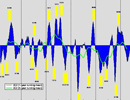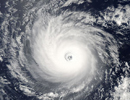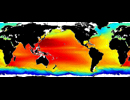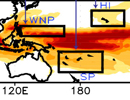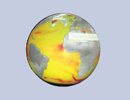Climate Anomaly Monitoring System ("CAMS") and OLR Precipitation Index (OPI), V0208
The "CAMS_OPI" is a precipitation estimation technique, which produces real-time monthly analyses of global precipitation. The observations from raingauges ("CAMS" data) are merged with precipitation estimates from a satellite algorithm ("OPI"). The analyses are on a 2.5 x 2.5 degree latitude/longitude grid, are updated each month, and extend back to 1979. This data set is intended primarily for real-time monitoring. For research purposes, we refer users to the GPCP and CMAP products which are more quality-controlled and use both IR and microwave-based satellite estimates of precipitation.
The CAMS_OPI data files contain, for each month:
- raingauge/satellite merged analysis
- gauge-only precipitation analyses
- the number of gauge reports in each gridbox
- OPI-only precipitation estimates
- gauge/satellite merged analysis anomalies (1979 - 1995 base period)
- anomalies expressed as a percentage of the Gamma distribution
The merging technique is very similar to that described in Xie and Arkin (1997), and the CAMS_OPI technique has also been published recently (Janowiak and Xie 1999). Briefly, the merging methodology is a two-step process. First, the random error is reduced by linearly combining the satellite estimates using the maximum likelihood method, in which case the linear combination coefficients are inversely propostional to the square of the local random error of the individual data sources. Over global land areas the random error is defined for each time period and grid location by comparing the data source with the raingauge analysis over the surrounding area. Over oceans, the random error is defined by comparing the data sources with the raingauge observations over the Pacific atolls. Bias is reduced when the data sources are blended in the second step using the blending technique of Reynolds (1988). Here the data output from step 1 is used to define the "shape" of the precipitation field and the rain gauge data are used to constrain the amplitude.
Reference:
Huffman, G. J. and co-authors,1997:The Global Precipitation Climatology Project (GPCP) combined data set. Bull. Amer. Meteor. Soc., 78, 5-20.
Janowiak, J. E. and P. Xie, 1999: CAMS_OPI: A Global Satellite-Rain Gauge Merged Product for Real-Time Precipitation Monitoring Applications. J. Climate, vol. 12, 3335-3342.
Reynolds, R. W., 1988: A real-time global sea surface temperature analysis. J. Climate, 1, 75-86.
Spencer, R. W., 1993: Global oceanic precipitation from the MSU during 1979-91 and comparisons to other climatologies. J. Climate, 6, 1301-1326.
Xie P., and P. A. Arkin, 1996: Global precipitation: a 17-year monthly analysis based on gauge observations, satellite estimates, and numerical model outputs. Bull. Amer. Meteor. Soc., 78, 2539-2558.
| Variables | Gauge-only precipitation (mm/day) Number of gauges OPI-only precipitation estimates (mm/day) CAMS_OPI combined precipitation (mm/day) CAMS_OPI precip. anomalies (1979-95 based) (mm/day) CAMS_OPI precip. anomalies as % of gamma distribution |
| Zonal | Global by 2.5 deg |
| Meridional | Global by 2.5 deg |
| Vertical | NA |
| Temporal | Jan 1979 to (present - 1 month) by 1 month(s) |
| Static? | no |
| Volume | 41 KB per variable per year |
| Server | public:      |
| Source | http://www.cpc.ncep.noaa.gov/products/global_precip/html/wpage.cams_opi.html |
| Acquired | Jan 1, 2005 (Updated Monthly) |
| APDRC contact | |
| Supplements | Readme |



